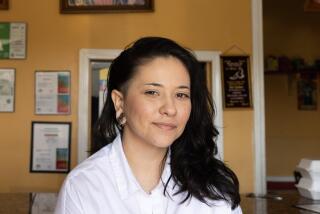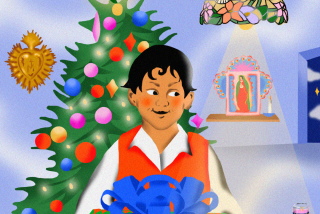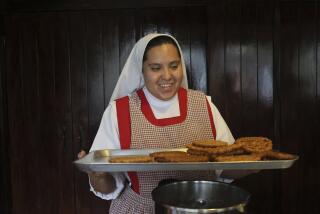Baptism’s Long Lines and Expenses Make Spiritual Step Big Business
- Share via
Every Saturday dozens of toddler and infant boys in white tie and tails and girls in flowing white christening gowns fill the pews at Mary Immaculate Church in Pacoima, waiting their turn for the splash of holy water that will mark their entry into the Roman Catholic Church.
Overwhelmed by sheer numbers and the children’s squawks and screams, the priest conducting the ceremony gets straight to the point. He reminds parents of their commitment to raising their child in the church and warns them against using the occasion an an excuse for overindulgence.
Then, row by row, with recorded Mexican folk music playing in the background, parents and godparents line up to approach the priest to receive the sacrament as cameras flash and camcorders roll.
Later, the many families head off to catered private parties at rented halls that, despite the priest’s admonition, include plenty of drinking and dancing well into the night.
In most Anglo parishes and English-speaking Protestant churches, small numbers of children are baptized at regular services once a month. But in churches serving Latino communities, the ceremony has shifted to a special Saturday night service and has become almost an assembly-line operation conducted weekly. Church officials said the mass baptisms began about a decade ago as a result of immigration and a high birth rate among Latinos.
Mary Immaculate is typical of Spanish-speaking parishes, where baptism ranks alongside quinceaneras-- the coming-out party for 15-year-old girls--weddings and funerals as life’s most significant milestones.
“In our community baptism is seen as essential when a child comes into a family,” said Father Bill Antone, a priest at Mary Immaculate. “It is a must in a traditional way, where in more Anglicized communities it is viewed more as an option.”
In addition to its spiritual significance, baptism is big business in the Latino community, said Jose Pimentel, a salesman at Lilian’s Bridal and Tuxedo Shop in San Fernando, where the pricey kiddie tuxedos and gowns are sold. The reason is simple. “Every child has to be baptized,” he said.
Several San Fernando shop owners specializing in baptism apparel and accessories refused to talk about the trade, either out of suspicion or competitiveness.
But the price tags at the shops tell much of the story. The little boys’ tuxedos start at $50, while the more elaborate girls’ christening outfits made of lace can cost more than $100. Add to that the fee for renting a local hall, as well as the tab for food, drinks, a photographer, a band, sheet cake, invitations, party favors and decorations, and the bill can reach several thousand dollars.
Carlotta Valdez, one of the owners of Valdez Dance Hall in Pacoima, said weddings and baptisms make up most of her business. The hall rents for $900, but that includes cleaning, guards, tables and chairs. “You have to bring your own decorations,” she said.
Martha Diego, whose son, Pedro Jesus, was baptized at Mary Immaculate last month, saved and planned for several months for the event. With the boy’s godparents covering part of the cost, she spent more than $2,000 for her son’s party, which was held at the local veteran’s hall and featured a live band and disc jockey.
“He’s my only son,” said Diego, a cafeteria worker born in Guadalajara. “All Mexican people have parties like that.”
A photographer hired for the event shot pictures of Diego and her son, as well as group shots of the friends and relatives who attended the service and the reception. Outside the church, other hired photographers posed their groups of customers around the parish grounds.
Father David Ullrich, of the Santa Rosa Catholic Church in San Fernando, said the social aspects of baptism sometimes overshadow its religious meaning. But trying to persuade parishioners to skip the elaborate parties is nearly impossible.
“You might as well talk to the wind,” said Ullrich, whose church is affiliated with Mary Immaculate. “We try to encourage simplicity, and not everyone is extravagant, but like weddings, there is a certain way people want to do it. Usually individual preferences will hold reign over religious values.”
Officially, the Los Angeles archdiocese has no position on what sort of celebration is appropriate for a child’s baptism, said spokesman Father Gregory Coiro.
“The proper advice is that this is primarily a spiritual event and one should not go into debt over it,” Coiro said. “But there is no way for the church to legislate that and if someone wants a big celebration, there is no way for the church to prevent it.”
Last year, more than 70,000 adults and children were baptized as Catholics, Coiro said. That is about 10,000 more than were being baptized a decade ago, church records show.
“There has been growth in Hispanic membership in the church, not only from births and baptism but from a constant influx from Mexico and the rest of Latin America,” Coiro said.
Father Antone, of Mary Immaculate, said when the parish was founded in 1954 it had a predominantly Anglo membership. That changed dramatically in the 1970s.
“Now we have 11 Masses over a weekend, four in English and seven in Spanish,” Antone said. “We have 7,000 to 8,000 attending over a weekend. The Spanish Masses are standing room only.”
Antone said he and his two other colleagues at Mary Immaculate are sometimes overwhelmed by the growth of the church, with as many as 45 children being baptized a week.
“Every once in a while we complain about the parking and the crowds and the noise but in the long run we feel really blessed,” Antone said.
More to Read
Sign up for Essential California
The most important California stories and recommendations in your inbox every morning.
You may occasionally receive promotional content from the Los Angeles Times.













